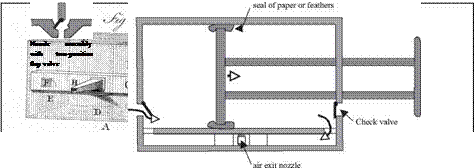Forge bellows and hydraulic energy for metallurgy
According to tradition Tu Shih, the prefect of Nanyang, “loved the common people and wanted to lighten their work”. This is why he decided in 31 AD to use hydraulic energy to power forge bellows, as we have seen earlier. Later in about 238 AD it is once again a man of Nanyang who spreads this technique to other metallurgical centers:
 |
“Han Chi, when Prefect of Lo-Ling, was made Superintendent of Metallurgical Production. The old method was to use horse-power for the blowing-engines, and each picul of refined wrought (iron) took the work of a hundred horses. Man-power was also used, but that too was exceedingly expensive. So Han Chi adapted the furnace bellows to the use of ever-flowing water, and an efficiency three times greater than before was attained. During his seven years of office, (iron) implements became very abundant. Upon receiving his report, the emperor rewarded him and gave him the title of Commander of the Metal-Workers.”[452]
Figure 8.20 The double-action piston bellows: a device to provide a continuous draft for Chinese metallurgy. Above: engraving of Chambers, 1757 (ancient archives of ENPC).
To understand the importance of this invention, whose usage becomes rapidly established in all of China, one must note how far advanced Chinese metallurgy was compared to that of the West.
Melting and casting were practiced in China very early. The key to this metallurgy is the quality of the furnaces and the draft of forced (blast) air that makes it possible to attain elevated temperatures. An illustration dating from 1313 shows the bellows mechanism powered by hydraulic energy (Figure 8.19). This consists of a horizontal water wheel at the upper end of whose (vertical) axis another horizontal wheel is fixed. Around this latter wheel there passes a belt that drives a third, smaller wheel, which therefore rotates more rapidly. The axis of this small wheel has an eccentric arm on which a cam pivots, thus introducing a rapid alternating movement which in turn activates the bellows.
The bellows itself was initially nothing more than a skin sack fitted with an outlet pipe for the air. Over time, wooden walls are added, and the bellows evolves into an extremely efficient device whose first known description dates from 1280. This was a double-acting bellows, consisting of a piston sliding in a parallelepiped that is divided into two chambers by the piston (Figure 8.20). As the piston moves back and forth, the air in one of the chambers is always being compressed. The evacuated air circulates through a secondary compartment, then into an exit nozzle with a pivoting flap serving as a check valve. Two such check valves also act on each end of the compression chambers. The edges of the piston are covered with feathers or paper to limit air leakage. This remarkably simple device delivers a continuous supply of blast air.






Leave a reply